Is hunger getting in the way of enjoying your hike? Take a look at these great snack options!
The top snacks for hiking include jerky, trail mix, Clif bars, and more. For children on a hike, squeeze pouches, yogurt tubes, and teething snacks are great options. Hikers who are allergic to nuts can rely on avocado and seed butter, and hikers with braces can enjoy banana bread or soup.
These are just a few of the delicious snacks you can take on a hike. In this article, I’ve compiled so many different snack options that take into account different situations and diets that no one is going to go hungry. Everyone on the trail is different and has different needs that need to be met, but luckily there are convenient options for each unique situation.
By the way, as an Amazon Associate, I earn when buying qualified products through links on my site.
As you move forward through this article, you’ll discover the top hiking snacks as well as snacks for diabetics, children, babies, and even those who are on gluten-free or keto diets.
Top 5 Most Popular Hiking Snacks
We asked over 300 hikers what they preferred to snack on, and you’ll be amazed at our results! Check it out:
| Snack | Number Of Voters |
|---|---|
| Trail Mix | 86 |
| Beef Jerky | 76 |
| Snickers | 43 |
| Fruit (bananas, apples, grapes, blueberries, mandarin oranges) | 35 |
| Dried fruit | 17 |
| Clif Bars | 15 |
| Peanut Butter M&M’s | 9 |
| Honey Stinger Stroopwaffle | 6 |
| Dark Chocolate Almond Clusters | 5 |
| Gummies (e.g. Sour Patch Kids) | 5 |
| Granola | 4 |
| Ramen Noodles | 2 |
| Pop-Tarts | 2 |
Trail Mix
Trail mix is a classic among hikers. It’s easy to make and travel with. According to healthline.com, trail mix is a great source of protein, healthy fats, and small amounts of sugar. It’s also a snack that is easy to adapt to your own preferences or dietary needs. The only potential downfall of trail mix is that some mixes may have too much sodium or sugar.
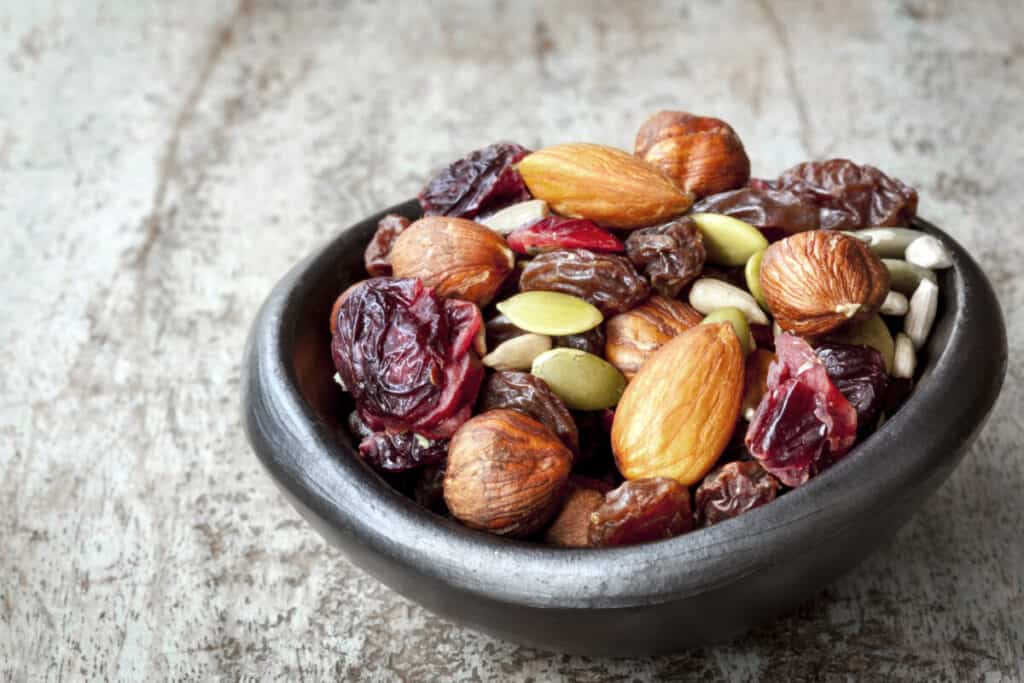
Trail mix is usually a mix of nuts and dehydrated fruits, and sometimes has chocolate or other candies. That opens up the possibilities for many different types of combinations.
Beef Jerky
Most types of jerky are packed with protein, but beef jerky is often the most common type that people come across. Because it’s lightweight, it makes for a great hiking snack. Furthermore, the drying process used in making jerky causes it to be leaner.
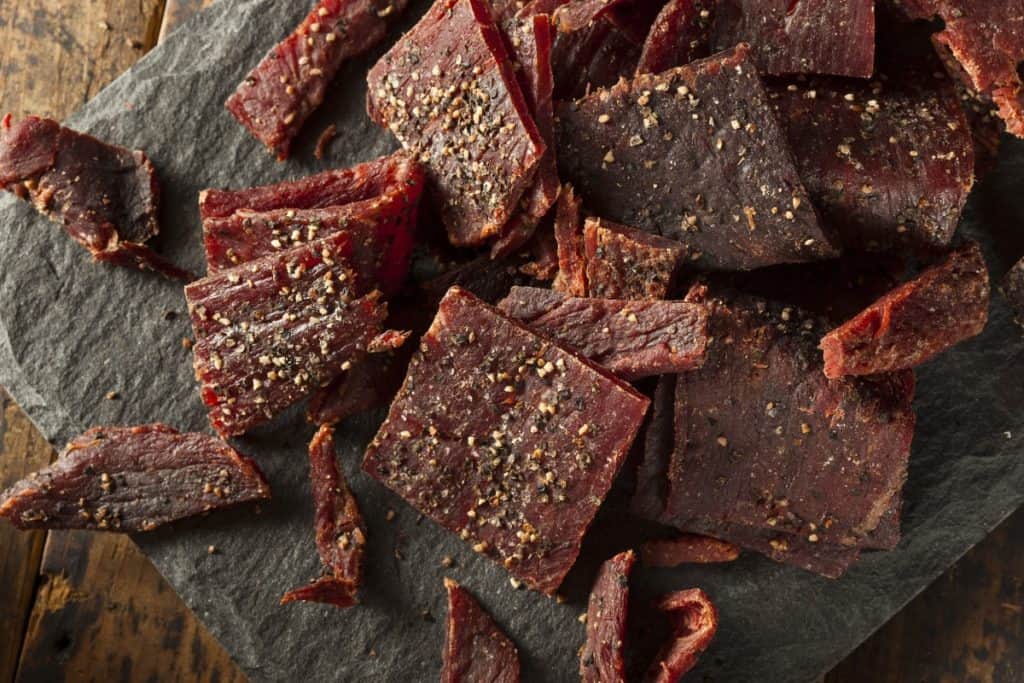
Just keep in mind that some store-bought varieties can contain preservatives you may not want in your food, depending on your preferences. If you really want to ensure you know every ingredient used, jerky actually isn’t too difficult to make on your own.
If you like spice, then Pemmiken’s peppered beef jerky is my absolute favorite that I can recommend.
Snickers
Although you can overdo it, Snickers are often considered a great treat for hikers who are on the trail. While moderation is needed, Snickers is one of the best candy bars you can bring on a hike due to the peanuts and salt included in the ingredients. For those who would prefer something that doesn’t come with a risk of melting, PayDays are also a good option.
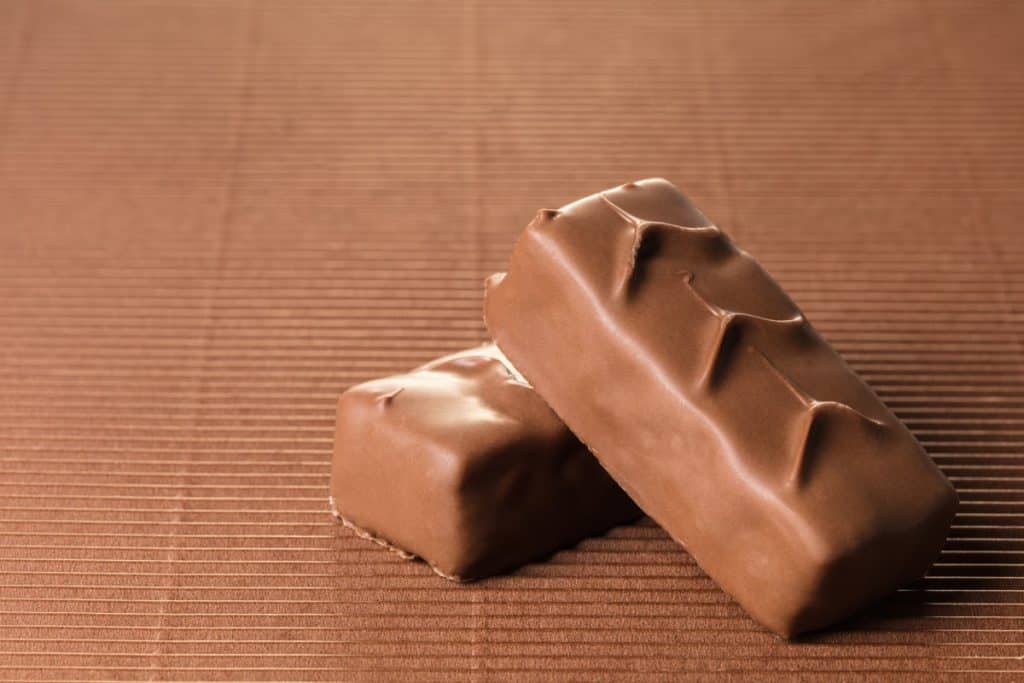
Just make sure this isn’t all that you eat–primarily sugar treats will give you energy in the short term but you need substance and protein to get through difficult hikes.
Fruit
Nature’s candy is a perfect snack when you’re on a hike. It’s sweet and delicious, but also contains fiber, vitamins, and minerals that the body loves. Most fruit doesn’t even need to be placed in a container, thanks to the outer layer of skin. Although fruit is a source of sugar, it’s worth noting that this sugar is naturally healthier than what you might find in candy. Fruit can help to make a snack more filling, but I would recommend bringing along jerky or nuts as well to get more complete nutrition.
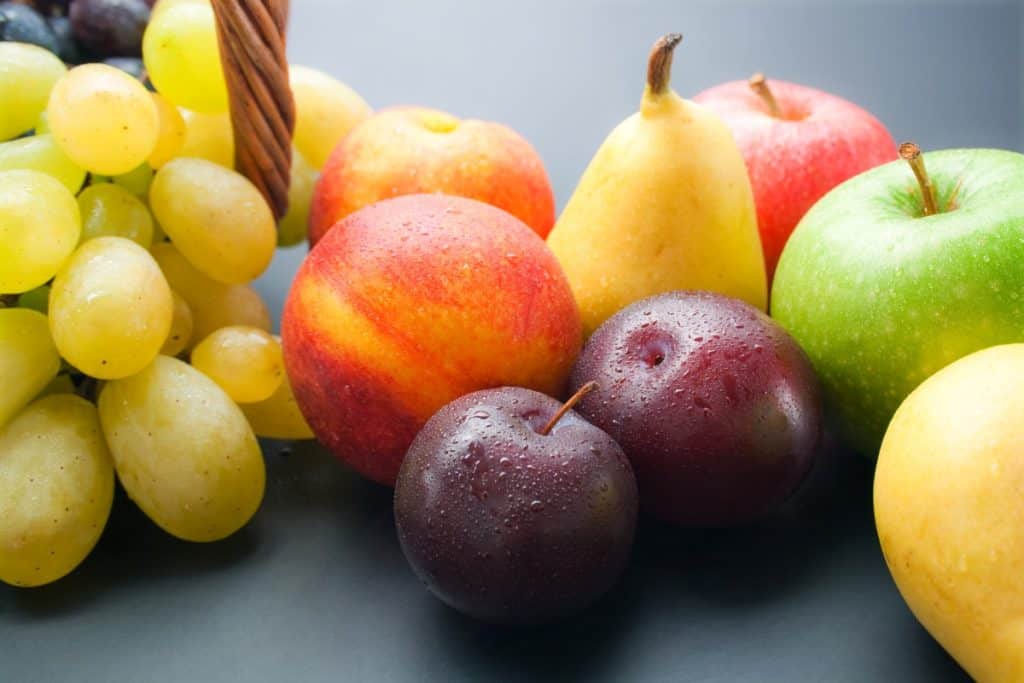
The benefit of fruit is that you can also dehydrate many kinds of fruit and it can go long way without refrigeration, which is perfect for long hikes.
Popular fruits are:
- Apples (you can eat the apple core. Really.)
- Mangos (have to take care of peels)
- Oranges (have to take care of peels)
- Grapes
- Plums
- Blueberries
Amazing dehydrated fruits are:
- Freeze-dried apples
- Freeze-dried strawberries
- Dehydrated Mango
- Dehydrated Grapes (also called raisins. 😀 )
- Dehydrated Cherries
- Dehydrated Cranberries
Clif Bars
These were technically 6th but could be considered 5th if you count fruit/dehydrated fruit as the same thing.
Clif bars are a staple for many hikers. They’re an easy choice when you want to be able to buy something prepackaged without having to worry too much about the ingredients. When you buy a Clif bar, you can trust that you’re getting solid ingredients like plant proteins, fiber, and healthy fats.
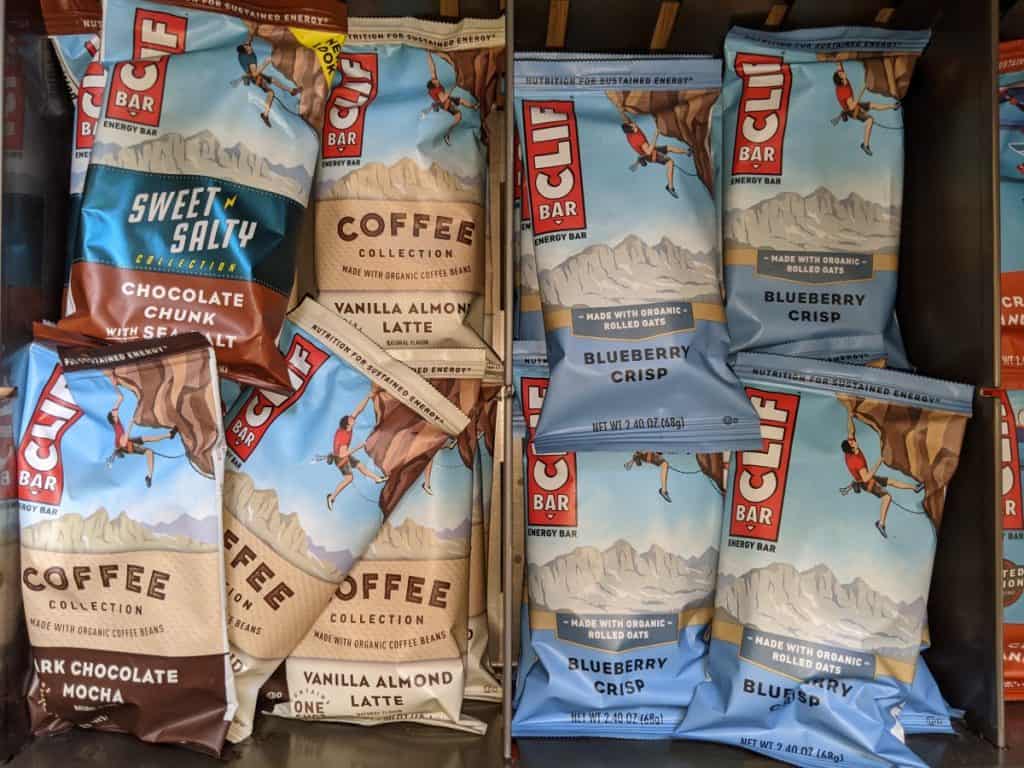
Additionally, there are a number of different types of bars and flavors. Clif makes bars that are made for bodybuilders, children, and anyone else who is too busy to sit down for their snack. With flavors like chocolate brownie, blueberry crisp, and even mini-bars in espresso and chocolate flavors, just about any hiker is likely to find a flavor they enjoy.
These are the top options for hiking snacks, but isn’t it also important to stay hydrated on a hike? To make sure you’re getting the most from your hiking food and beverage choices, take a look at our article on the best hiking drinks here.
Hiking Snacks For Taste
You would think that when you’re hiking that you would be super hungry for anything–however if you’re like me and many others, it’s just not like that.
For some reason, certain things become super appetizing while other things become repulsive. Here are some ideas for different types of flavors.
Salty/Savory Hiking Snacks
Let’s start with the salty/savory snacks:
Ramen Noodles
Many people may often think of ramen as a meal, but it can actually be used as a snack when you’re on a tough hike. Interestingly enough, the sodium that can be a problem in regular situations can actually be helpful when you need electrolytes.
The first method you can use if you want to have ramen as a hiking snack is to simply eat it dry. This limits the utensils and containers that get dirty. It’s also easier to eat this way without stopping, though it is a good idea to at least slow down while you’re eating. Additionally, drink plenty of water. The dry ramen can be scratchy or even uncomfortable to eat.

Secondly, you can boil some water on the trail using a backpacking stove and cook it that way. Pre-cooking ramen isn’t the best idea since the noodles get really soggy and gross.
If you want to eat Ramen Noodles as a soup while you’re hiking, I recommend the instant cup noodles. They are super easy because you can cook them in their own container (although you now have a styrofoam cup you need to pack out.)
Bagels
Bagels are a great food to bring along on a hike. They’re easy to eat on the go and are less likely to break down or be squished in your hiking pack. You can also get some added nutrition along with the bread if you choose to bring along options like everything or whole wheat bagels.
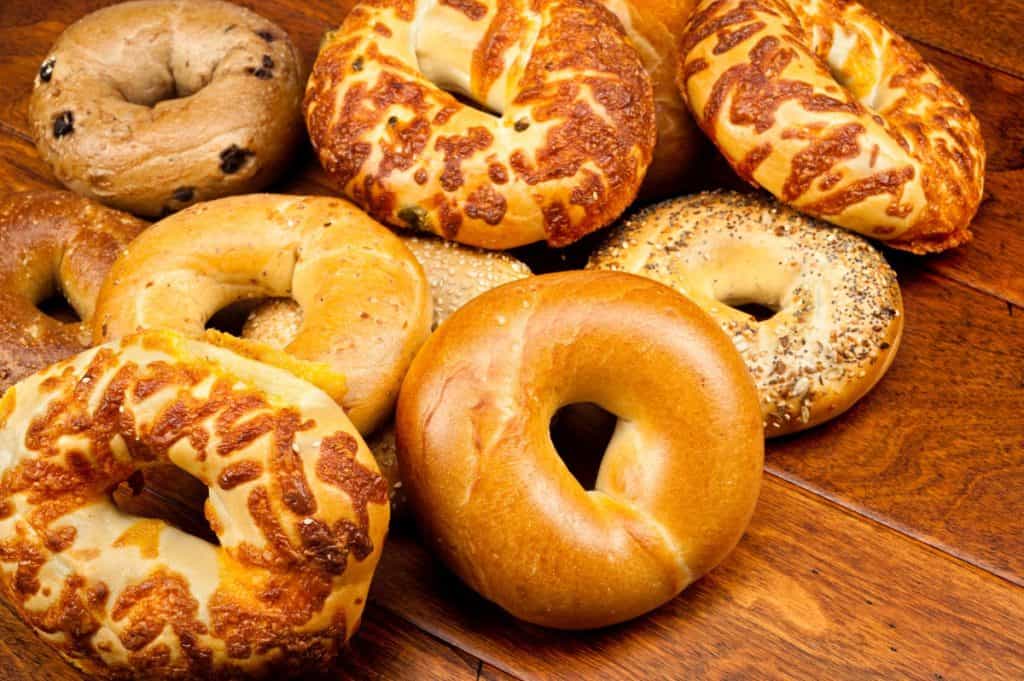
If you’re able to keep your snacks cold without too much trouble, you can bring along some cream cheese to add to your snack. Those who don’t have that option can instead opt for peanut butter, avocado, or even hummus.
Like ramen, bagels can also work well as a lunch option while you’re on a hike. If you plan on hiking long enough to need lunch, it’s important to know what you should bring to keep your hunger at bay. Take a look at our article here to learn about some great hiking lunch ideas.
Seeds
Like nuts, seeds are a great source of healthy fats. The biggest difference tends to be that you’d need to eat more seeds in order to get enough of the benefits. That said, there’s nothing wrong with bringing along something like sunflower seeds or pumpkin seeds out onto the trail. They are still very beneficial.
If you want to, you can even add some of your favorite seeds into your trail mix or another recipe. Some may add chia seeds to other snacks in order to add nutrition. Fans of everything bagels can use various seeds to create their own everything seasoning for other foods. Additionally, seeds can be added to yogurt, granola, and even bread.
Protein Pancakes
Pancakes are often thought of as a meal, but there’s no reason you can’t pack some into a Ziplock bag and bring them on the trail. They can be quite filling and you can even add some peanut butter to add a little more substance to them.
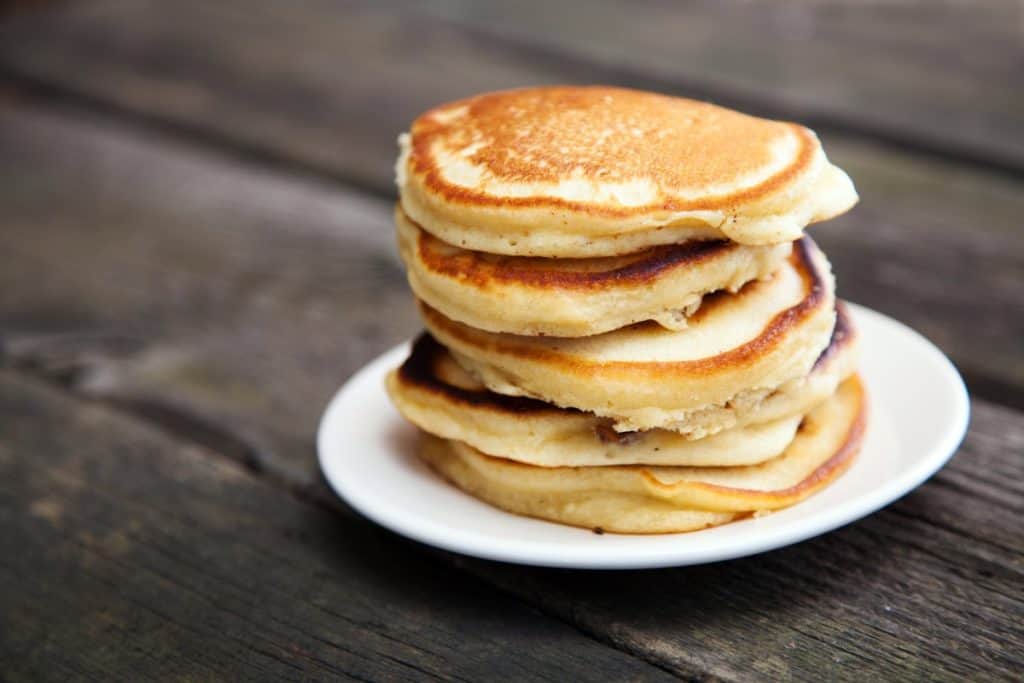
If you want to, you can bring regular pancakes on your hike. However, some may want something with more nutrition. Protein pancakes are a great way to get more protein with your carbs. There are ways you can make your own protein pancake mixes, or you can pick up some Kodiak Cakes if you’d prefer to put in less effort. The latter option is made with ingredients like whole wheat flour as well as protein from both whey and milk.
Popcorn
A light and easy option, popcorn makes for a decent snack. It may not be as filling as other options, but it’s great when you just want to munch on something without too many consequences. You can also combine that popcorn with more nutritional ingredients like freeze-dried fruit or nuts.
What’s great about popcorn is that if you’d prefer something sweet, it can also be combined with M&Ms for a tasty treat. Kettle corn is amazing and you’ll love it on the trail.
The one thing I want to warn you is to make sure and bring dental floss if you’re eating popcorn on the trail. Yeah, I know, bringing floss while on a long hike sounds pretty silly–but popcorn has a habit of getting stuck in your gums and you don’t want to have that nagging at you all day (or potentially for multiple days) while on the trail.
Peanut Butter Pretzels
Peanut butter often shows up in lists like these because it’s an easy, relatively inexpensive source of healthy fats. Combining that peanut butter with pretzels gives you both the fats and the salt that can be incredibly necessary while you’re on a hike.
For those who haven’t had them before, peanut butter pretzels are salty, crunchy pretzel pockets with a nice scoop of peanut butter inside. They’re cleaner and easier to eat than some other options, and you only really need a handful to keep your body going. Just be careful, these tasty little snacks can be very addicting.
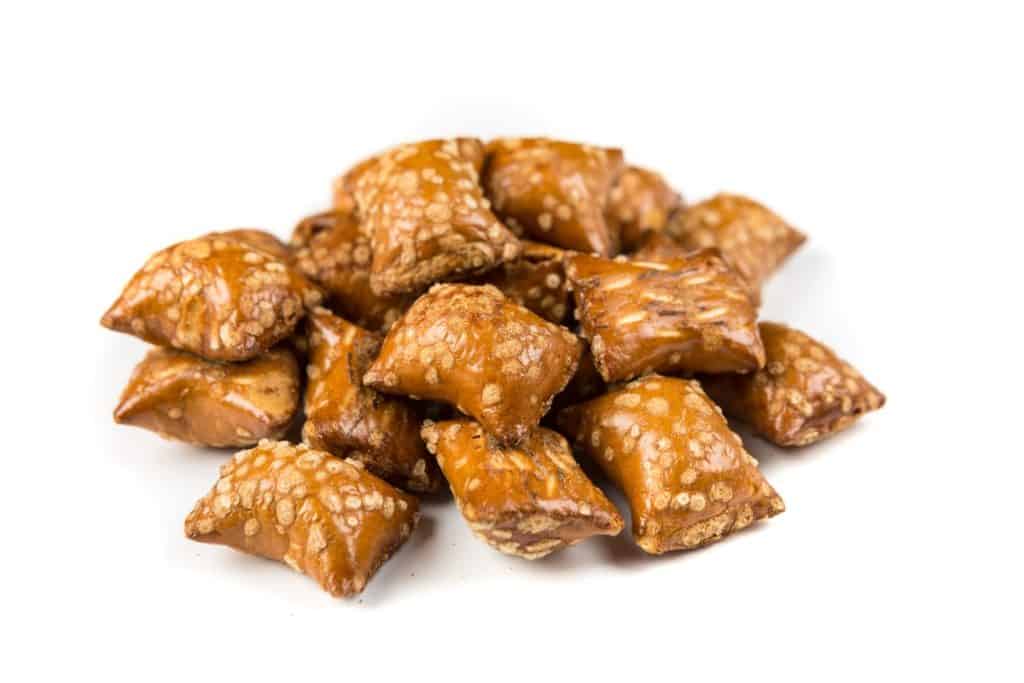
Also, these snacks have a lot of salt and are super dry–make sure you have extra water to handle these fellas.
Other Great Salty Snacks For Taste
I won’t duplicate all the information, but here are other ideas for salty snacks that you can find in this article:
- Beef Jerky
- Hummus
- Summer Sausage
- Crackers (Triscuits, Wheat Thins, Ritz Butter Crackers, Saltine)
Sweet Hiking Snacks
Sometimes when you’re hiking you crave something sweet and hearty–this section should satisfy:
Chocolate Covered Espresso Beans
Not only are chocolate-covered espresso beans delicious, but they also provide a caffeine boost that some hikers might feel like they need on a hike. On top of that, it’s a lot easier to bring along a package of espresso beans than a cup of coffee if you want your caffeine on the go.
The only potential downfall with espresso beans is that it can be easy to eat a lot of them since they are small. As a result, you can end up suffering from the consequences of too much caffeine. According to Livestrong.com, there are about 5 milligrams of caffeine in each espresso bean. That amount can vary by brand, so always make sure to check the caffeine levels. For comparison, a single 8-ounce cup of coffee can contain around 100 milligrams.
Snickers
Snickers are one of the most popular hiking snacks–and it’s no wonder! Snickers are a delicious blend of salty peanuts and caramel and chocolate.
On top of that, eating Snickers actually feels like you’re eating something substantial. 1 fun-sized Snicker bar is around 70 calories while a full-size candy bar is around 200 calories.
Perhaps you won’t (and probably shouldn’t) fill up on Snickers, but they’re delicious and are great hiking food.
Peanut Butter M&Ms
Much like Snickers, peanut butter M&Ms are a delicious treat that can offer a little bit more than just sugar alone. Whereas Snickers offers peanuts to boost the nutrition of the snack, these M&Ms are filled with peanut butter and create a similar salty-sweet (mostly sweet) experience.
Some also prefer these M&Ms to other options because they are a bit less likely to melt. That said, it’s still a good idea to try to keep them cool enough to keep the outer shell intact. Just like other sugary snacks, make sure to use moderation when it comes to peanut butter M&Ms.

Why hold back? Well, it’s possible to have too much of a good thing while you’re hiking. My dad made a huge batch of trail mix that had peanuts, M&M’s, and about everything else you can imagine. I can no longer eat peanuts mixed with anything–something about the extremely strenuous nature of difficult hikes combined with too many flavors really did me in. TL;DR: you can get sick of food you love if you overeat it while you’re hiking.
Dark Chocolate Almond Clusters
Almonds are a fantastic snack to bring along on any hike. Whether you want to have them by themselves or as part of a chocolate-covered treat, you can’t go wrong with them. Turning them into dark chocolate almond clusters just makes them easier to enjoy. These clusters are a great source of healthy fats. On top of that, you can even get a little bit of caffeine from dark chocolate.
Dark Chocolate Dipped Coconut Macaroons
Not all sweet snacks are going to be particularly healthy, but what better time is there to indulge than during a calorie-burning hike? These macaroons are lightweight and very easy to pack along. Additionally, they contain both carbs and sugar–perhaps not good for losing weight, but definitely can work for hiking.
Honey Stinger Energy Waffle Or Stroopwafels
If you’ve never heard of Honey Stinger Waffles before, they’re definitely worth a look for hikers. A combination of carbs, honey, fat, and sodium, these waffles strive to give hikers the energy they need to keep going.
Additionally, Honey Stinger Waffles are easy to travel with and consume. They’re sweet, thanks to the honey involved, and can give you a nice boost when your body needs it the most. Because they are treats, they also come in a number of flavors like vanilla, cinnamon, and salted caramel.
Honey Stingers are essentially stroopwafels, a famous Netherlands treat. If you haven’t tried them, they are amazing.
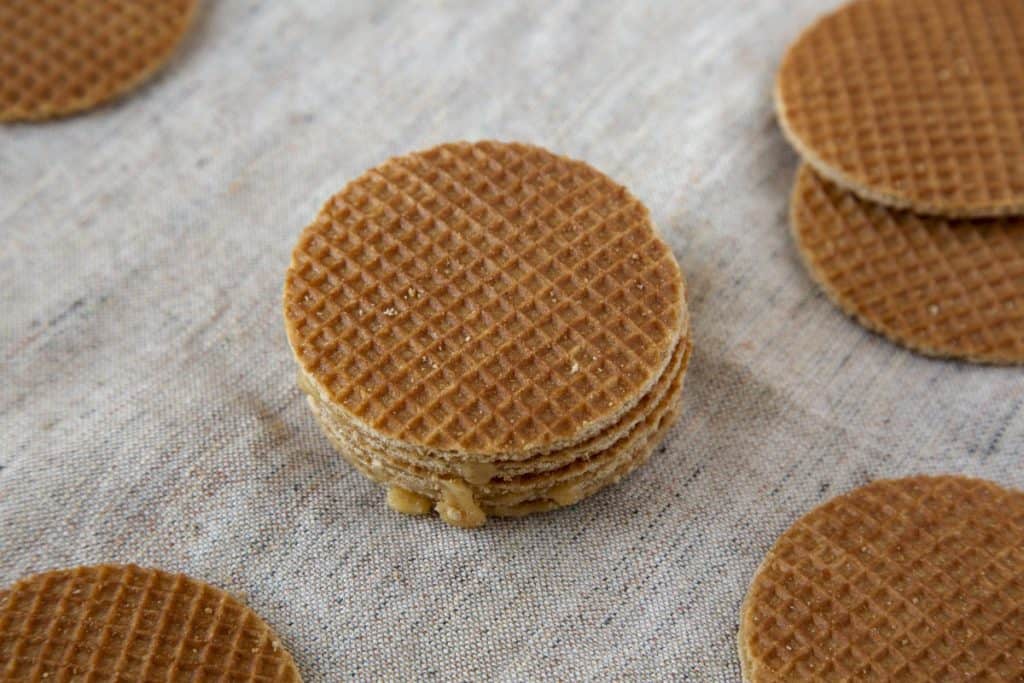
Honey Stingers come in a convenient pouch and are good for eating on the go–but if you can find any stroopwafels (in the world foods section if you’re going to find it at all)
Other Great Sweet Snacks For Taste
I won’t duplicate all the information, but here are other ideas for sweet snacks that you can find in this article:
- Fruit Smoothie (can be frozen)
- Yogurt (can be frozen)
- Cereal/Granola Bars (plenty have a lot of sugar)
- Yogurt Drops
- Energy Balls (Peanut Butter Balls)
- Dehydrated Fruit
Fancy Hiking Snacks
These aren’t necessarily the best for the month-long Appalachian through-hike–but if you’re trying to impress somebody with incredibly fancy but definitely hike-possible foods, read on:
Specialty Trail Mixes
When most of us think about trail mix, we tend to think about the standard options easily found in a grocery store. Yet, not everyone favors the combination of peanuts, raisins, and M&Ms we’re so familiar with. Luckily, there are many more trail mix options out there for you to try.
If you take a look around the internet, you can find some pretty interesting trail mix options. Just a few I’ve come across include jerky trail mix, tropical trail mix with pineapples and bananas, and even some modeled after the delicious taste of S’mores. For those who really want to try something unique, the Slow Your Roll trail mix includes some interesting ingredients like sprouted nuts and coconut chips.
Here are a few fancy trail mixes that we make:
The 4 Cs
- Dark chocolate chips (70% or darker)
- Unsweetened large coconut flakes (not the finely shredded sweetened stuff)
- Salted cashews
- Dehydrated tart cherries
Islander
- Sliced dehydrated plantains
- Dehydrated Mango
- Macadamia nuts (these are a real joy)
- White chocolate chips
Kashi Kablashi
- Kashi
- Greek yogurt chips
- Freeze-dried strawberry
- Sliced almonds
Autumn Blend
- Pumpkin seeds (Pepitas)
- Dried cranberry
- Dried apple
- Pecans
- Halved walnuts
Charcuterie
While it may not be the most convenient snack, there are few who can deny the deliciousness of a good charcuterie board. You’ll likely have to take a break to enjoy the food, but I would be lying if I said it wasn’t worth it.
Generally, charcuterie is made up of hard cheeses like cheddar or gouda, meats like summer sausage or salami, and fruit to add a bit of sweetness to the mix. If you want to, you can bring dried fruit or even veggies if you make your own. On the other hand, there are pre-made charcuterie packs you can get at the store. Just pay attention to any ingredients that may need to be kept cold.
Many summer sausages don’t need any refridgeration. If you can find sealed cheese or find cheese that doesn’t need refrigeration this can actually work for long-distance hiking.
Freeze-Dried Snacks
Freeze-dried foods have become more and more popular over the years. At one point, most may have only pictured flavorless emergency foods when the idea was presented. However, these days you can find freeze-dried fruit, candy, and even avocado pretty conveniently.
If you do want to try out the more emergency-minded varieties, brands like Mountain House do offer freeze-dried treats like peanut butter bites and ice cream bars. Those who want to get fancy can even seek out pepperoni pizza cheese crackers and Italian breadsticks in the form of MREs.
Dark Chocolate
That’s right… just dark chocolate.
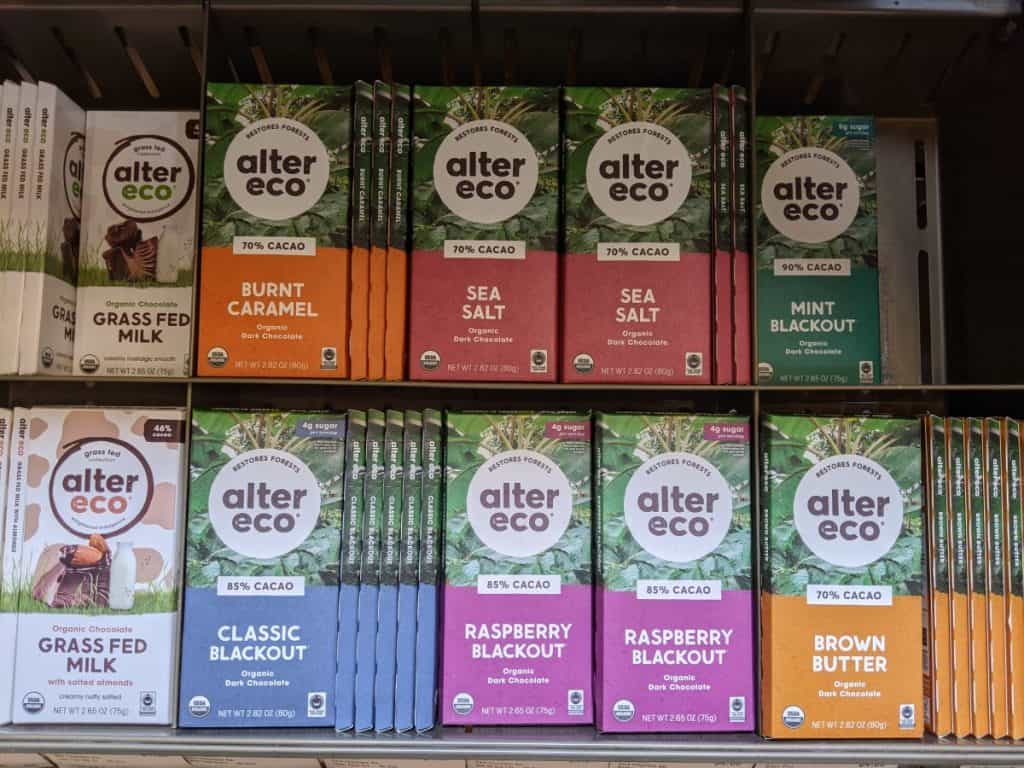
Alter Eco (and other brands) sell dark chocolate bars with high dark chocolate content which means a lot of fat. They come in different flavors to ease the bitterness of the chocolate.
I’m one of those weirdos that enjoy dark chocolate with no extra flavors… but your mileage may vary.
Fancy Sweets
From time to time, hikers like to bring something extra special along on the trip. The difficulty in this is that fancier sweets can be more prone to breaking, melting, or going bad. In some cases, they may even be difficult to carry if they’re too large.
However, I discovered in my research that hikers will bring along all kinds of fancy treats. These might include some of their favorite donuts, no-bake cheesecake, or apple dumplings. In some cases, hikers were even willing to bring an entire pie along on the trail.
I know from my own hiking trips with my dad and brother that my dad would pick up those cheap powdered donuts from the gas station right before heading out on the trail.
If you can’t tell how old it is at the gas station, there’s a good chance it will last you a good long while before going bad on the trail.
There are definitely fancier options. But… just sayin’.
Seafood Snacks
Seafood lovers might be left feeling like their options are limited for a hiking trip. Aside from seafood-flavored noodles or canned tuna, what else is there? The good news is that there are a lot of options.
A little browsing through Amazon led me to find various types of seafood-based jerky, like salmon jerky, tuna jerky, and even eel jerky. Additionally, there are other dried options like bento squid and dried shrimp. While you might need to stock up on items like these through the internet, there are plenty of options for those who need seafood in their life – and on their hikes.
Hiking Snacks For Braces
Soup
For those who are wearing braces, soup can easily become a go-to meal. You can’t be too careful when it comes to the food you eat, and soups typically require little to no chewing. Additionally, there are many different flavors to choose from, from tomato soup to something a little more filling like beef and mushroom soup.
Additionally, soup is a great food for taking on the go. Just get it nice and hot and pour it into a well-insulated thermos. That will keep it warm until you’re ready to have some. On cooler days, a warm soup can be an excellent pick-me-up.
Ramen Cup Noodles are excellent options but there are several out there that are fancier.
Baked Chips
Most chips aren’t a great idea when you have braces, but there are a few selections that are typically safe. These include pretty much all baked chips, Pringles, and veggie sticks. These options are less likely to get stuck within your braces. Nobody wants to deal with little chip pieces stuck in a place where they cannot be brushed or flossed out.
Pudding
It’s pretty easy to determine why pudding is a safe food for those who are wearing braces. The tasty dessert doesn’t require any chewing at all, so it won’t cause any damage or discomfort. Furthermore, there are a variety of flavors available that you don’t even have to cook.
For the sake of hiking, the pudding may need to be kept cool. You can opt to make the pudding yourself and place it in a travel-safe container, or buy pre-made Snack Packs that don’t need refrigeration as long as they haven’t been opened. Because pudding you make yourself includes milk as an ingredient, it’s best to keep it in a cooler or with ice packs.
Soft Cereal Bars
If you’re normally someone who likes to munch on granola bars, you might be disappointed to find that they aren’t the best snacks for braces. However, soft cereal bars can work as a decent replacement. They’re less chewy, lightweight, and they come pre-packaged.
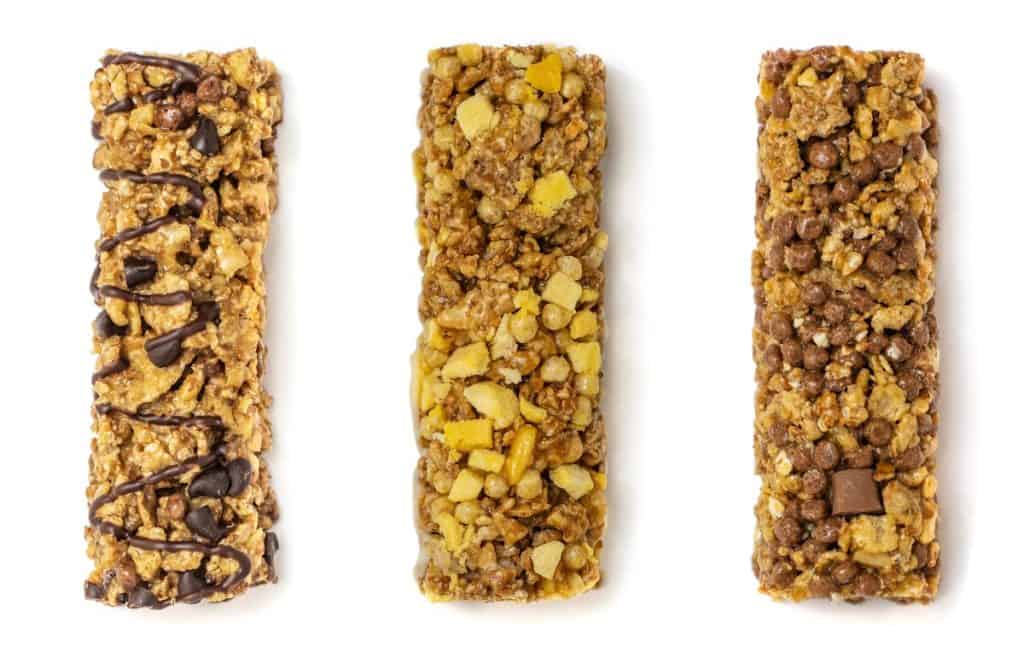
Because of that, they’re easy to bring on a hike. The biggest difference between soft cereal bars and granola bars is that the former can be a lot sweeter. Often, these cereal bars are filled with sweetened fruit fillings. That said, you can find organic options out there that will at least try to keep all that extra sweetness natural.
Banana Bread
Who doesn’t enjoy a fresh loaf of banana bread? It’s delicious and a bit more filling than other bread options. It’s also soft enough to enjoy even with braces on your teeth. Furthermore, banana bread is a convenient way to make sure you’re getting the fruit your body needs.
Many will argue that it’s best to make your own banana bread. There’s just something about the homemade variety that makes it special. You can also adjust the recipe for any dietary needs, and it comes out fresh and warm. That said, banana bread can also be purchased at most grocery stores if you don’t want to make it yourself.
Crackers
Graham crackers, Ritz Bits, or mini cracker sandwiches, Triscuits, Wheat Thins, and so on–there’s no shortage of cracker options. Some crackers have cheese or peanut butter to add a little more nutrition to the snack.
You can’t go wrong here unless you are trying a hard or dense cracker.
Hiking Snacks For Energy
Energy means two different things–caffeinated or carbohydrate-dense. Let’s talk about both of them:
Protein Shake
Protein shakes are excellent for any kind of exercise. During long multi-day hikes, they can be a great resource for keeping on muscle mass that isn’t being used. Additionally, protein shakes are easy to pack, make, and drink. Just find a flavor you enjoy as well as any additions that might make the drink more enjoyable. Whether it’s a snack or a replacement for a whole meal, protein shakes are a great choice.
Nuts (Peanuts, Almonds, Cashews, Walnuts, Pecans, You Name It)
Nuts of all types are packed with carbohydrates, fat, and protein–nuts can be considered superfoods since these three crucial things are the building blocks of energy.
You can get more immediate energy from carbohydrates, and you can get long-term energy from the fat, and you need protein to repair your spent muscles (source) (as well as for energy).
If you’re looking for a energy-packed snack for your hike, most types of nuts will work wonders.
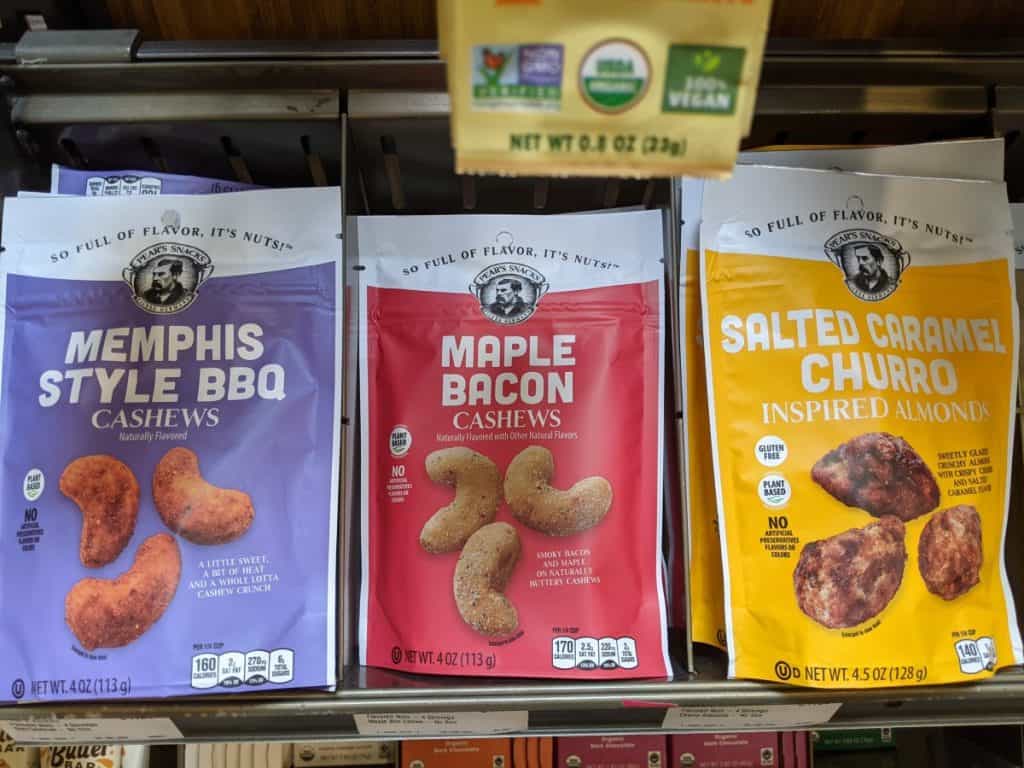
Additionally, if you don’t like the taste of raw cashews or peanuts by themselves, there are tons of flavoring options. For example, Pear’s Snacks makes Maple Bacon Cashews. Flavored nuts might help the trail food feel less monotonous.
Energy Gels
When you’re racing while biking or running, people often reach for food that your body can absorb quickly for energy. This does work–however hikers don’t necessarily want energy for the next 30 minutes, but rather 8-12 hours depending on how long they’re hiking that day.
If you’re hiking long distances, energy gels won’t provide you the necessary nutrition to sustain you throughout the entire hike (you’ll want something left for your body to have when you’re resting).
If you combine energy gels with more sustanent food, then you have a good combo.
GU sells massive flavored energy gel packs:

Some people experience a boost of the feeling of energy from a caffeine uptake–remember that caffeine is a more active brain and not a more energized body. Use it with a combination of actual nutrition and you’ll get the best results.
Energy Chews
Energy chews come with the same disclaimer as energy gels–but if you’re providing enough nutrition and real energy for your body and you’re just looking for a pick-me-up–then energy chews aren’t a bad option.
Honey Stinger (the people who make the little waffles that I talk about above) come in with Honey Stinger Energy Chews–you can think of this as a replacement for a sports drink (like Gatorade)–except that you don’t have to carry all that liquid.

Honey Stinger’s energy chews (read more about them on their website, here) focus on sodium and sugar (like a sports drink) which can help you rehydrate and give you some energy. Remember, these are no substitute for real meals, but can help postpone a sugar crash and give you a pick-me-up.
Quinoa
Many favor quinoa because of its versatility. On top of being quick to prepare, quinoa can work as an excellent addition to sweet or savory snacks. You can bring along some quinoa made with bullion, or with fruit. Some use this handy ingredient as an alternative to rice or oatmeal.
Hikers who cook during their trip can find it to be easier to use than other options, but you can also cook it beforehand to bring as a snack if you’d like.
Quinoa is packed with energy and nutrition, here are just some of the nutrition facts from healthline:
In 1 cup of quinoa:
- Calories: 222
- Protein: 8 grams
- Fat: 3.55 grams
- Carbohydrates: 39 grams
- Fiber: 5 grams
That’s just the basics but quinoa has a lot of other macro-nutrition as well such as folate and iron.
Ants On A Log
A classic snack for children, ants on a log is an energy-boosting option to bring along on a hike. The combination of vegetables, healthy fats, and a little bit of natural sugar makes it a reliable way to keep your strength up.

For those who aren’t as fond of the standard variety, ants on a log can also be customized by replacing the guacamole or cream cheese, and the raisins with beans, other fruit, or even bacon.
Meat Bars
No doubt you’re familiar with jerky, but have you ever had a meat bar? Jerky bars are great for getting a high dose of protein in a compact way. Brands like Epic provide meat bars in many different varieties, using meats like chicken, beef, bison, and even venison.
If you’re looking for a high protein choice that is also keto-friendly, this is a solid way to go.
Easy Hiking Snacks
Sometimes getting together snacks can feel pretty overwhelming. That’s why in this section I wanted to list some easy hiking snacks that easy to prepare, buy, and eat.
Wraps
Similar to sandwiches, wraps are very easy to prepare and bring on a hike. Essentially, any sandwich you can make on bread, you can also make in the form of a wrap. Another benefit wraps offer is that they are less likely to get soggy. From a simple layering of Nutella all the way to a chicken caesar salad you can hold in your hand, wraps are simple to make and easy to enjoy.
Edamame
Edamame is an extremely simple way to get higher amounts of fiber and protein. This bean does need to be cooked before you can eat it, but that can be as simple as roasting, steaming, or microwaving. As you’re cooking, you can also add a variety of different seasonings, like garlic, parmesan, or even chili powder. Once they’re cooked, you can toss them into a sandwich bag and go.
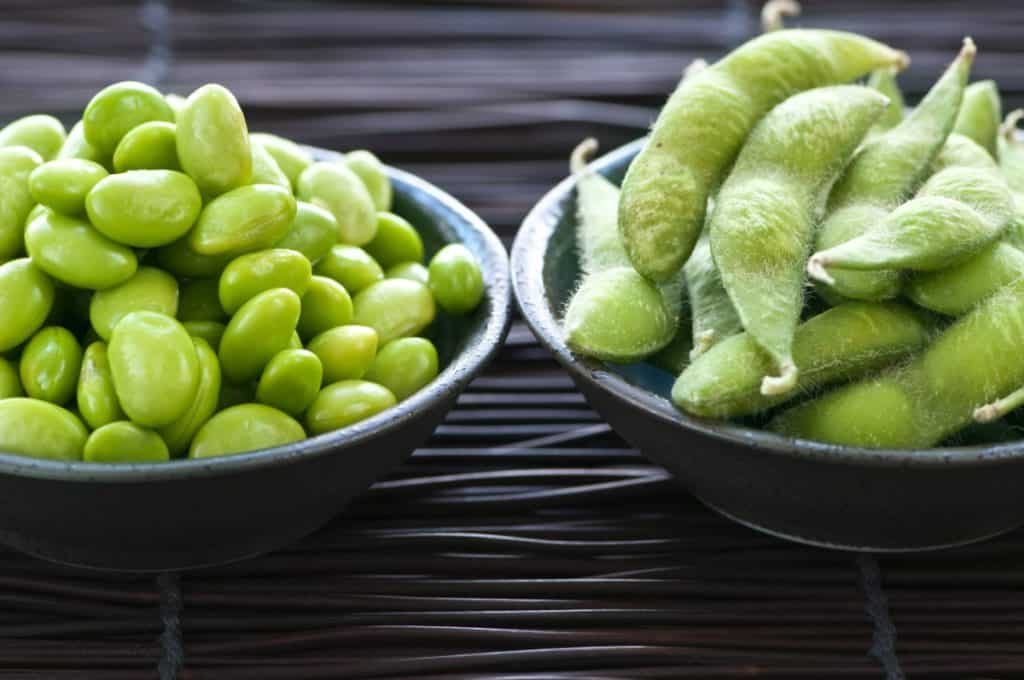
Careful though, edamame is addicting–I’ve eaten through way too much, before. Also, if you’re hiking you probably want to remove the soy beans from their pods because the pods aren’t really edible and you’ll have a bunch of empty pods to deal with on the trail.
Turkey Sticks
Although adventurous chefs can find ways to make their own turkey sticks, they can also be purchased in clean, easily-contained pouches. Like jerky, turkey and other meat sticks are low in fat and abundant in protein.
Turkey sticks are also high in sodium, which can be helpful when you need to replace electrolytes. Just don’t overdo it!
Crackers
Just about any grocery store you go to is sure to have a huge variety of different crackers. From the fundamental saltine all the way to fancy Club Crackers.
Prepackaged and lightweight, crackers work well as a hiking snack. This is especially true if you pair them up with cheese, summer sausage, or dips. You certainly don’t have to, but some extra additions can add important fuel for your body.
Pro tip: remove the crackers from their box and pack the crackers in their plastic bag (or another plastic bag if they came only in the box). This will save some bulk in your pack when hiking.
Cracker ideas:
- Triscuits: I admit, these are my favorite. They come in a ton of different flavors and they’re delicious with cheese or hummus.
Fruit Leathers Or Dehydrated Fruit
A fruit leather is a flattened and dried piece of fruit paste. It is similar to eating jerky, except it’s fruit.
Fruit is always a healthy choice, but it isn’t always the easiest to eat. Fruit can be sticky and juicy – a great way to end up with uncomfortably sticky hands. Those who want to avoid this issue, or who just want something lighter to carry, can opt to bring along fruit leathers instead.

You can also get vitamin c, sodium, and potassium from dehydrated fruit or fruit leathers. Just be aware of the added sugars.
Easy To Make Hiking Snacks
So, there’s easy to buy and bring, but what about easy hiking snacks to make? Here are some ideas:
Bottle Salads
A salad can be a refreshing snack (or meal), especially on a hot day. Crisp, fresh lettuce, and delicious fruit or vegetables can really give you a boost when you’ve been exercising. You can stow your salad in a wide-mouthed water bottle or some tupperware–you can make and carry as many different kinds of salad as you want with these containers.
Just make sure you either eat the salad within a few hours or find a way to keep it cool.
Sweet Potato Rounds
Potatoes and potato chips are delicious, but they aren’t always the most nutritionally dense. As a healthy alternative, sweet potato rounds are easy to make and give you more of what you need to keep your body moving. According to this recipe from the Fork In The Road blog, the only ingredients you need are sweet potatoes, olive oil, and seasonings of your choice.
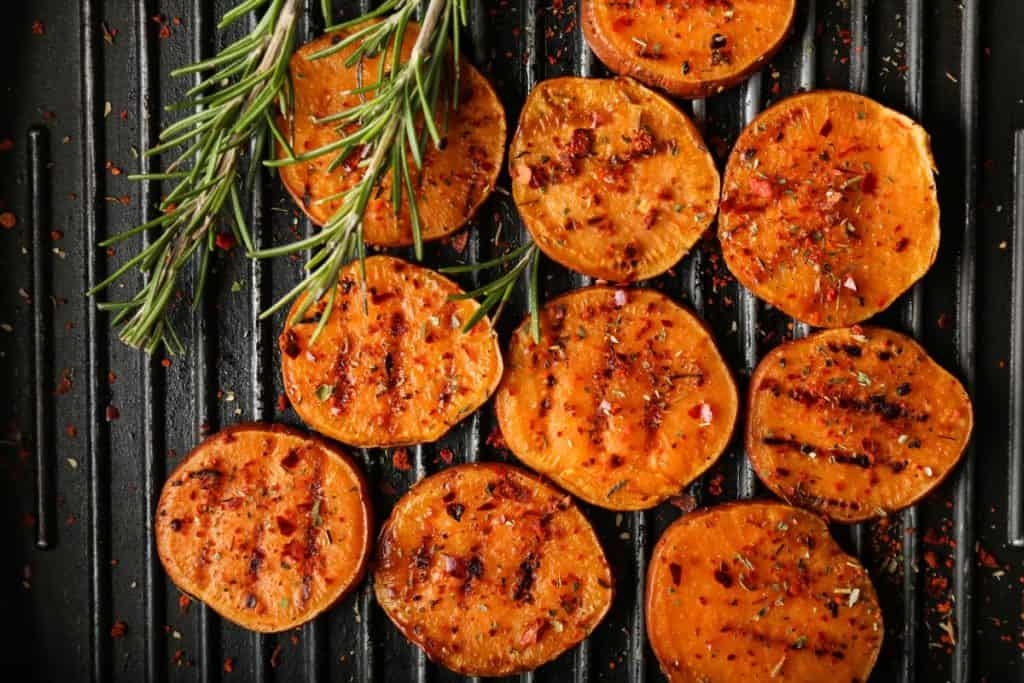
Yogurt Parfaits
You can certainly bring yogurt on a hike, but using that yogurt to make a parfait can be even more rewarding. Yogurt parfaits are great sources of protein, and you can add to the nutrition by including granola and your favorite fruit. This is an option that will need to be kept cold, but it may just be worth it if you’re a fan of parfaits.
One idea is to freeze your groups water bottles and use this as a makeshift ice chest to keep your snacks cool. A reflective container (like those insulated lunch bags) will help keep out the heat.
Energy Bites
Energy bites are great because they feel like a dessert, but provide a lot when it comes to nutrition. This recipe from the Gimme Some Oven blog includes ingredients like peanut butter, honey, oats, flaxseed, and delicious chocolate chips. As a result, you’ll get healthy fats, fiber, and other benefits that will keep your energy stores from running out. These bites don’t even need to be cooked.
These are some of our favorite on the go snacks–we use them for hiking and car rides and they are pretty easy to put together.

You can use chocolate, coconut, peanut butter/almond butter–we like to use chia seeds and oats as well to add bulk to these delicious treats.
Bean Dips
Dips are a fun way to get a bit more nutrition while still enjoying some crunchy chips. With bean dips, you get protein and fiber that you wouldn’t get with chips alone. Consequently, your body will get more energy for the hiking journey. A bean dip can also be as simple as refried beans and cheese mixed with some salsa, or you can take it up a notch by adding sour cream, jalapenos, or green onions.
Take note that the sour cream and cheese will go bad first–the bean paste itself will last a while.
Age-Appropriate Hiking Snacks
Sometimes we get so wrapped up in snacks that we forget about the kids who also need to eat–and also have a hard time trying certain foods like edamame or hummus. Here are some snacks that work well for certain ages (and adults too)
Hiking Snacks For Toddlers
Toddlers are a tricky bunch, let’s figure out what they can eat.
Peanut Butter And Jelly Sandwiches
Peanut butter and jelly sandwiches are often a staple for children – and for good reason. In a peanut butter and jelly sandwich, you get healthy fats, some fruit-based sugars, and some carbs. These are all things kids need to keep their energy levels up. Not to mention, it’s delicious.
This of course works only if nobody has a peanut allergy–you can always use almond butter if that’s the case. If there’s a tree nut allergy, sunflower seed butter is a thing!
A standard PB&J sandwich is enough, but you can also choose to make mini sandwiches for your child. The Must Have Mom blog provides instructions on how to arrange your mini PB&Js into adorable shapes with no crust to worry about. If you’re in need of a no-prep option, there are also some organic pre-made PB&J bites you can easily pack into a hiking bag.
All this research is making me want a PB&J.
Bites Of Produce
Fruit and vegetables are good for everyone–and they’re a great hiking food.
Toddlers are a little particular since there is always that choking hazard. The only prep you need is to cut up the vegetables and fruit in a way to be as safe as you can. Remember if you are hiking and eating or otherwise out and about, running or walking around with a full mouth is quite a bit more hazardous.
Depending on what you choose to bring, you may need to handle the food in different ways. Options like peaches and apples can be cut up into thin little slices that are easy for children to eat. Meanwhile, grapes can be cut into halves, for example.
You know your kid and what they’re capable of, so just imagine your kid bopping around and potentially tripping and that should give you an idea of what fruits and vegetables will work.
Baked Goods (muffins, cookies, brownies, etc)
Baked goods can have a lot of versatility, making them pretty great as toddler snacks. You can use baked goods as treats instead of candy by bringing along some of your child’s favorite cookies, brownies, or even cakes. You can even have fun baking (I mean… as much fun as you can have baking with a 2-3 year old) them together if you want, or you can bring along some pre-made options like Gerber’s banana cookies or soft-baked grain bars.

Some baked goods can also work as a method for getting your child to eat some fruit or vegetables. Muffins are a great way to do this. You can easily add carrot, zucchini, or fruit like pineapple to muffins, making them more palatable to a young child.
The problem we have is that our son will eat 60% of a muffin and leave the rest. And then eat 60% of another muffin.
Squeeze Pouches
Adults can find a smoothie to be a convenient method for getting themselves to eat fruit or vegetables that they might not normally be interested in. The same is true for toddlers and squeeze pouches. These pouches are small, easy-to-carry, and self-contained – making them a lot less messy than giving your child a typical smoothie. Which works a lot better for on the trail eating.
You can also find a wide variety of options to meet the flavor preferences of your child. Packed with healthy ingredients, squeeze pouches contain fruit like pears, kiwi, apples, and blueberries alongside vegetables like spinach, kale, pumpkin, and sweet potato. Additionally, some choices even add in oats, chia seeds, oats, and coconut milk. There are both standard and organic varieties.
Our son’s favorite squeeze pouches are just plain applesauce.
Yogurt Tubes
Yogurt is a great snack for little ones. It’s delicious, healthy, and contains important probiotics. Yogurt tubes make eating yogurt easier for children or for those who are on the go. This makes them a perfect choice for hiking with toddlers. Just make sure to keep them cold so they don’t go bad. Freezing the yogurt tubes beforehand works really well.
One of the most common yogurt tube options is Go-Gurt, but that may not be the ideal choice for everyone. Those who prefer organic options might prefer the yogurt tubes offered by Simple Truth. You can even find dairy-free options for little tummies that don’t quite agree with lactose.
Hippeas
We’re one of those millenial parent families that feeds their kids non-chip chips. Sometimes feeling different is just as good as being actually awesome!
But there’s one brand of “chips” that we really like called “Hippeas”. They are essentially chickpeas in puffed form.

It begs the question if you put the cheese powder on it (there’s multiple flavors) if it’s really better than potatoes or corn… but hey–these are a great snack for hiking and other outdoor activities that we really enjoy and our son will eat, too.
Cheerios
Cheerios are often a favorite among parents. They’re cleaner than many other food options, easier for toddlers to eat on their own, and don’t pose a choking risk.
Toddlers can get some fiber and protein from Cheerios, with low levels of sugar. While they won’t give a child all the nutrition they need, Cheerios have plenty of nutrition to be used as a snack. Furthermore, babies as young as 7 months old can easily eat Cheerios on their own.
Chips
A lot of foods these days seem to be geared towards sweetness. This is certainly true for children’s snacks as well. If you want to give your little one a break from sweet flavors, chips can provide some more savory flavors. Like many baby snacks, chips designed for toddlers dissolve quickly. They’re ideal for toddlers who are at least 12 months old.
There are also a wide variety of flavors ranging from cheddar to Gerber’s organic white bean hummus. As a result, you can explore new flavors with your toddler in a way they’ll dig. Just make sure any flavors you bring along on a hike are ones you know they’ll enjoy, too and you’ll be golden.
Hiking Snacks For Babies
And here we are at one of the trickier people to plan for on a hike. You have to figure out the right baby carrier, and you have to figure out the food. If your baby is already weaned or you’re introducing solids then here are a few ideas of some foods to eat:
Purees
Baby food purees are a common food for little ones who are working their way toward eating solid foods. There are a wide array of puree flavors available, from strawberry to green bean to meats like beef and chicken. To make sure the puree is still safe to eat, refrigerate it well beforehand, and don’t wait more than 2 hours to give it to your baby. If you want the puree to last longer, it may be a good idea to freeze it before packing it for your hike. Otherwise, a cooler or some ice packs may be very useful.
Puff Snacks
Cheerios may be a popular choice, but not all babies are fond of their bland flavor. For those babies, puff snacks can be a fantastic option. They come in a lightweight container that’s easy to take on the go and offer flavors like banana and strawberry apple. Like Cheerios, these snacks also contain low amounts of sugar. Instead of added sugar, the makers of these snacks focus on natural flavors.
Yogurt Melts
Yogurt is a great snack for babies, but it can be difficult and messy. Not to mention, babies younger than 12 months old may not understand how to use yogurt tubes just yet. Because of that, yogurt isn’t typically an option a parent might think of when they are packing baby snacks for a hike. Yogurt melts, like those offered by Gerber, can make yogurt a more travel-friendly option.
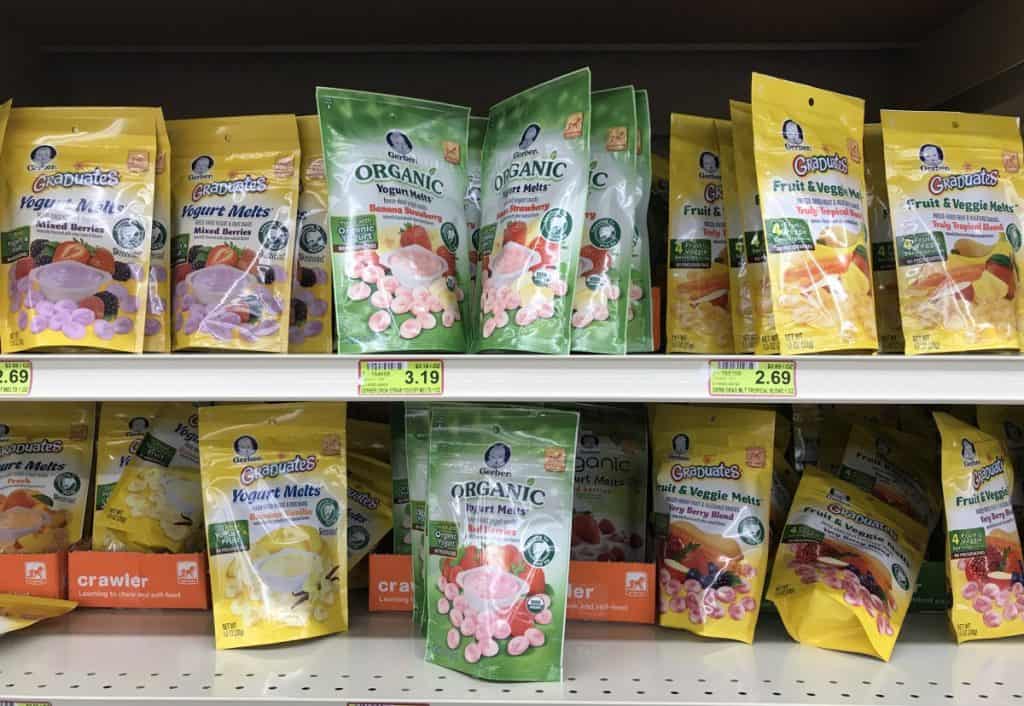
Plus, these things are actually pretty tasty. I’m not recommending stealing from a baby or anything like that…
Teething Snacks
Teething snacks are perfect for babies who might get fussy about their growing teeth. Most parents are well aware that babies can become restless and grouchy while their teeth are coming in. It’s a good idea to keep some teething wafers on hand like these from Gerber (found on Amazon). They may not be the only option, but they are one you can use if you want to combine teething relief with a light snack.
Formula (If Needed)
For some babies, formula is a staple. Meanwhile, others may just have it as an alternative when they can’t have their milk directly from the source. You might not think of it for how long your hike is, but it never hurts to be prepared–it’s a good idea to bring some formula (or breastmilk) on your hikes if you’re going to be hiking for more than an hour or so. Remember that you might need to warm up the milk or formula before offering it to your baby.
Diet Hiking Snacks
Hiking is a strenuous activity and it can almost feel just as strenuous to try and figure out what to eat, especially when you’re on a diet, medical or no. Let’s talk about a few diets to try and show some options:
Hiking Snacks For Diabetics
Sandwiches
Sandwiches are a reliable classic for just about anyone. They can be just as good for diabetics as for anyone else, but they do require a little more thought. Lean meats are an ideal choice, paired up with cheese. Whole grain or sprouted bread is ideal according to Healthline.com. This is largely because typical white bread can contain too many carbs that can have negative effects on blood sugar.
If you’re doing just a day hike for a few hours, then one pro tip is to put all the fixings together in a separate container from the bread so you don’t get soggy bread. You can also use those condiment packets that you keep in your car (come on… we know you have some)
Clif Energy Shots
Managing diabetes means keeping blood sugar levels within a healthy range. In some cases, low blood sugar requires fast solutions. According to WebMD, glucose gels are a great way to remedy low blood sugar quickly.
Clif Energy Shots are glucose shots that can cover this need as well as provide an energy boost. They’re light, compact, and easy to eat. Additionally, they come in a huge variety of flavors like raspberry, vanilla, and even mocha.
If you don’t carry an insulin pen, this might be a good alternative to carry around just in case.
Fruit Snacks Or Gummy Bears
While some might turn to specialized products like Clif Energy Shots or other glucose gels, others look for other kinds of snacks that might aid them in keeping their blood sugar from getting too low. Fruit snacks and gummy bears can be solid options for this situation. Both can provide some sugar without too many other unwanted ingredients. Because of their small size, you can also have more control over how much your blood sugar is raised.
I’m not a diabetic, but I will say that fruit snacks are probably the most delicious thing you can have on a difficult hike. I’m not sure why, either.
Almonds
Almonds are highly recommended for those who have diabetes. They pack large amounts of nutrition into a small package. According to this study by the National Library Of Medicine, having almonds regularly can be very helpful in controlling blood sugar levels. Just a handful can provide highly helpful minerals like riboflavin and manganese as well as healthy fats.
High Protein Hiking Snacks
Cured Meats
Cured meats are some of the most popular choices for hiking. There’s a good reason for this, considering these meats tend to last longer without refrigeration than others. When many think about cured meats, they might think of jerky or salami, but this type of meat can include meat sticks and even pre-cooked bacon.
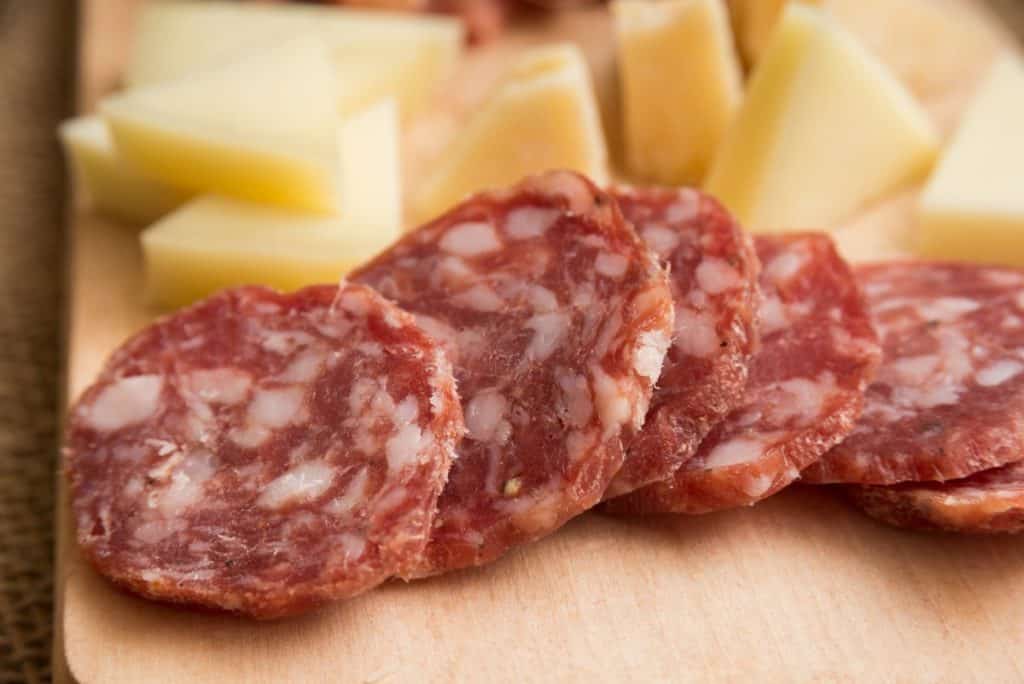
Whichever kind you choose, make sure you’re familiar with how to keep it fresh for as long as possible.
Chicken Or Tuna (chicken of the sea) Packets
What could ruin an outing in nature more than thinking about all the dishes that will need to be done after? Chicken packets, such as those made by Starkist, can help you to avoid that issue while still getting plenty of protein. It may not be the most exciting option, but you can combine the chicken from the packet with additional ingredients to create chicken salads, tacos, or wraps.
Summer Sausage
Summer sausage is an incredibly easy protein source to bring on a hike. You can find it in just about any store and there are a variety of sizes and flavors to choose from. In addition to that, you don’t have to worry about refrigerating summer sausage as long as the package hasn’t been opened.
Make sure and bring a pocket knife so you can slice the summer sausage while you’re on the move. It doesn’t taste near as good for some reason to eat it like an apple. I wouldn’t mention it if I didn’t have personal experience.
Tuna Pouch
Much like the chicken packets I mentioned previously, tuna packets can make for an easy way to get some protein while you’re on your hike. If you want to, you can use the tuna to make a sandwich or wrap. Otherwise, you can simply pair it up with some crackers.
There’s little worry about getting any extra dishes dirty and you can simply pack the packet away for the end of your hike when you can throw it away.

These ones I found at REI have some nice additional flavoring, but salt and pepper can go a long way if you get the plain kind. These are packed with protein.
Vegetarian Hiking Snacks
Hard-Boiled Eggs
If you’re a vegetarian that eats eggs, this is a great hiking snack.
Most vegetarians probably know how important it is to find protein sources that meet their needs. Eggs are a great way to do this. Eggs contain a lot of nutrients, including phosphorus, lean protein, and many different vitamins. Just remember that hard-boiled eggs are best for single-day trips. After the first day, there’s a greater chance the eggs will go bad.
If you’re fortunate enough to have access to unwashed eggs, the eggs can last (unwashed) for days.
Nut Butters
Peanut butter has been the unrivaled nut butter of choice for a very long time, but it’s not the only nut butter out there.
The following kinds of nut butter are also good options:
- Cashew butter
- Hazelnut butter
- Walnut butter
- Pistachio butter
- Almond butter
- Macadamia butter
These other nut butter types are worth taking a look at if you don’t like peanut butter, or just want something different. Healthy fats can be found in all types, as well as unique benefits offered by the different kinds of nuts.
Oatmeal Cookies
While cookies are generally considered a fun treat, oatmeal cookies can actually provide some healthy nutrition. Fiber, sodium, fats, and potassium can all be found in them. Consequently, they’re great snacks to take on a hike and you can expect to get more from them than some carbs and sugar. If you like customizing your recipes, you can make them yourself. Otherwise, many grocery stores and bakeries will carry them–although they usually go heavy on the sugar.
Granola
Granola is a fantastic vegetarian (and even vegan) choice for those who want a solid boost of energy. Made up of different kinds of nuts, oats, and flavorings like cinnamon, granola provides healthy fats, fiber, and protein.
Another great benefit is that you can put together your own granola recipe and eat it as a cereal or add it to baked goods, salads, or even make your own granola bars.
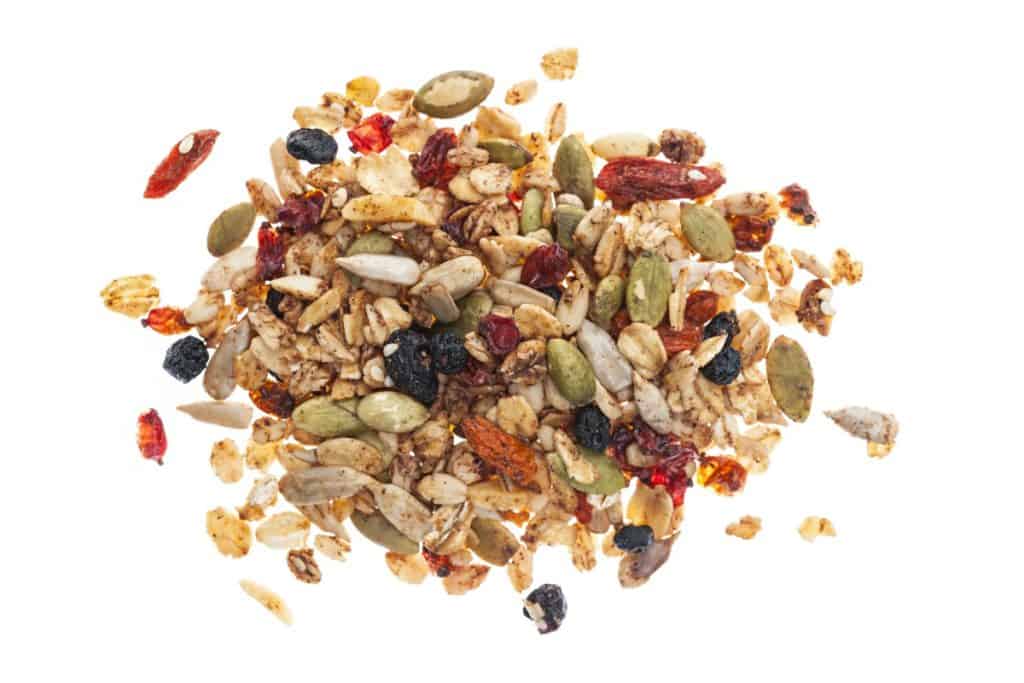
This is actually one of my personal favorite hiking snacks. If you have a granola recipe you like, you can bring a few lbs of it on a big backpacking trip. It works as a snack and a meal.
Tofu Jerky
Jerky is a great option for those who are okay with eating meat, but what about something similar for vegetarians? Tofu is a great source of iron and protein that can be dehydrated and turned into its own kind of jerky. You can add whatever seasonings you like and pack it along to easily snack on while you’re on the trail.
Vegan Hiking Snacks
Hummus
Hummus could be considered a kind of superfood, especially for vegans and vegetarians. With ingredients like chickpeas, sesame seeds, and olive oil, hummus can be relied on for a variety of benefits.

Hummus has the amazing ability to go with many different types of food. Whether vegetables or crackers or just plain by itself, hummus is a winner. But if you haven’t tried hummus with pita chips, then you have something to look forward to.
Veggies
Most people are familiar with the kinds of benefits that come with eating vegetables. Fiber as well as important vitamins and minerals make vegetables a highly important part of everyone’s diet. You also don’t have to worry too much about them going bad on a hike unless you’re going to be out in the heat for multiple days.
To really create a solid snack, pair up the veggies with some hummus.
Some veggies that work well and have some nutrition:
- Carrots
- Bell Peppers
- Broccoli
- Steamed Brussel Sprouts
- Green Beans
Cucumbers and celery don’t have much in the way of major nutrition, but they are packed with water and will help with staying hydrated.
Smoothie
Smoothies work well for just about any diet preference because they are so adaptable. When it comes to the vegan diet, smoothies can be packed with fruit and vegetables, and nut butter, and can be mixed up using ice and water or fruit juice. The only downfall is that it’s best to consume them while they’re still cold or have the ability to keep them cold while you’re hiking.
If you have a container that can handle it, you can freeze the smoothie to make it go much farther. If you can find a way to insulate the container, even better.
Dried Fruit
Dried fruit carries a lot of the same benefits as fresh fruit, but without the added weight. Their dehydration also means that dried fruit can last longer. Because it’s lightweight and compact, it’s easy to take on a hiking trip. According to Healthline.com, dried fruit can contain around 3.5 times the minerals, vitamins, and fiber than fresh fruit. The only vitamin for which that isn’t true is vitamin c.
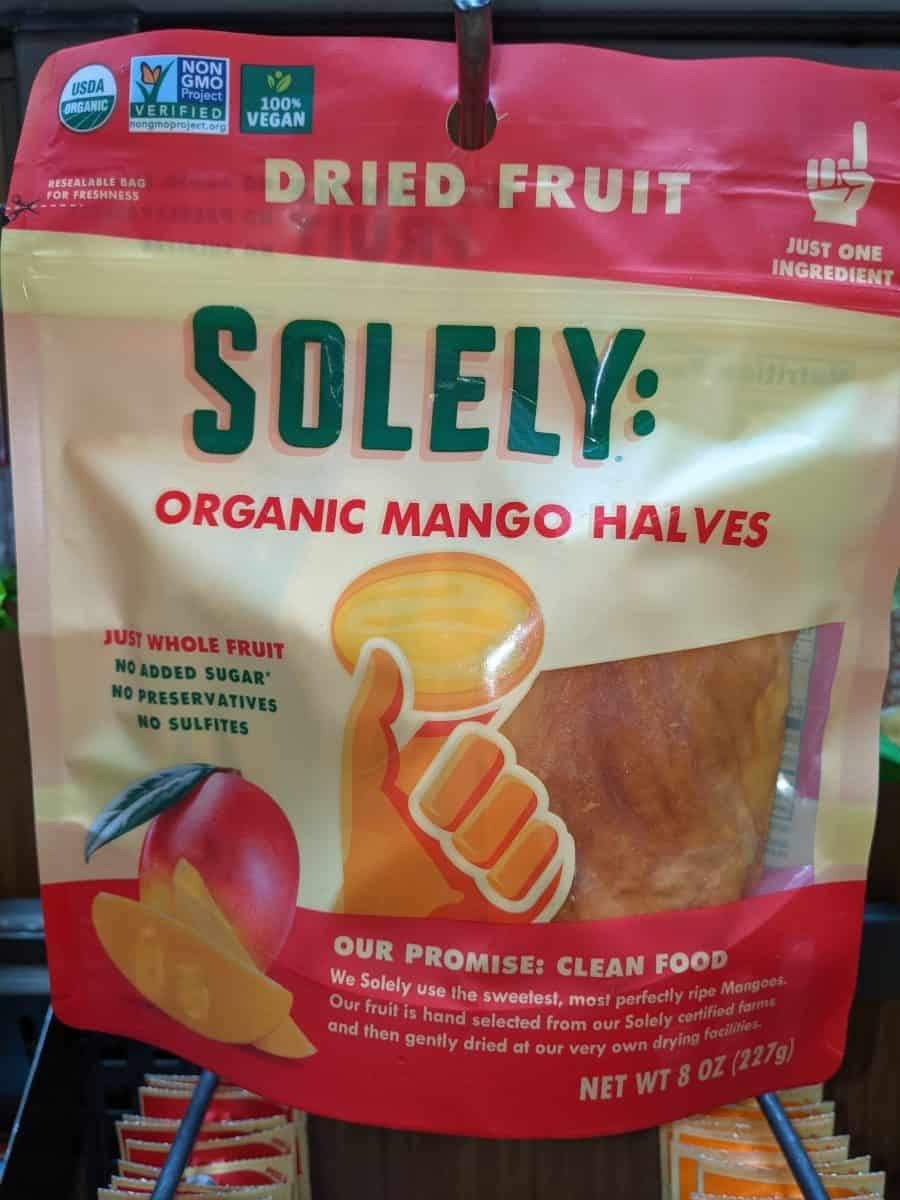
There are many dried fruit options that don’t have any unnecessary added sugars, as well. Dried mango is a hugely caloric (mostly from sugar) snack if you want energy on the trail.
Soylent
As a specialized product, Soylent is intended to provide complete nutrition in the form of a drink. There are ready-to-drink and powder varieties. Both of which contain healthy fats, soy, and allulose as a gentler form of sweetening. Soylent uses vegan-friendly products and is easy to mix up and drink whenever needed. Consequently, it’s an easy solution for hiking.
The only challenge is that when you’re hiking sometimes the “medicine” meals can be difficult to have motivation to eat. If you know yourself, don’t pack a ton of stuff that you don’t enjoy eating, because when you’re really exerting your body sometimes these foods get even more difficult to eat.
Keto Hiking Snacks
Cheese
WebMD discloses that the main goal of the keto diet is to consume high amounts of fat and protein and keep carb intake low. Cheese is an excellent choice for meeting this need. Options like mozzarella and cheddar are great because they are also easy to bring on a hike. You can pack along some hard cheese wrapped in cheesecloth or even some string cheese.
String cheese or other softer cheese are good to place right next to your frozen water bottle so they can stay fresh longer.
Whisps
Whisps are a specialized snack that is geared toward those who are seeking out low-carb or gluten-free options. They look a little bit like Cheez-Its but come in a wider variety of flavors. In each pack, there are between 21 and 29 grams of protein.
Protein is an important factor in staying energized and strong even on a tough hike–it will help your body recover from the intense exertion of hiking.
Keto Bars
There are bars for just about everything these days. Granola bars, protein bars, and now keto bars. Because these bars are specifically designed for those who are on the keto diet, they come with large amounts of fat and protein.
Most of these bars also only contain about 3 grams of carbs. You can also find Keto Bars in a variety of flavors like chocolate peanut butter and mint chocolate.
Keto Bricks
Unlike Keto Bars, Keto Bricks pack more of a punch. As the name implies, Keto Bricks are large enough to cover about half of the calories typically needed by adults. Each bar comes offers 1,000 calories and around 92 grams of fat and 36 grams of protein.
It’s a great option if you’re planning on taking a longer, more intense hike. If you want to make them easier to eat as snacks, you can also cut them up into smaller pieces.
Gluten-Free Hiking Snacks
Energy Bars
Bars of different kinds have been making themselves useful as snacks. These days, there are options out there for just about every preference and dietary need. When it comes to gluten-free options, you can turn to brands like Kind Energy, RxBar, GoMacro, and Larabar.
There are more gluten-free bars in addition to these, but the options I’ve listed here are some of the most popular and include many different flavor choices.
Olive Pouches
So you love olives, but an entire can might be a bit too heavy to bring on your hike. Olive pouches are a lighter option that you can bring as a snack. Because they are low in calories and fat, it might be a good idea to have something else alongside the olives. That said, olives do have a decent amount of sodium to aid in keeping up your levels of electrolytes.
Spam
Because Spam is a meat product, you can rely on it to function well as a gluten-free snack. It’s also highly versatile. You can use Spam to make sandwiches or quesadillas, or you can dehydrate it to eat by itself. Furthermore, Spam is shelf-friendly, so you can bring it along on multi-day hikes without having to worry about it going bad.
That is… if you like spam. I don’t, personally, but many people do, especially with the right condiment.
GU Chews
Not everyone wants a heavy snack for their journey. Some would rather have a snack that provides the most nutrients in the smallest package. GU Chews are a great option for that situation. These chews come in small packages and appear somewhat similar to Airheads candies. However, instead of large amounts of sugar, these chews include electrolytes, amino acids, and carbs that are very helpful during hikes.
This is similar to the Honey-Stinger chews I talk about earlier.
Swedish Fish
There are a number of different candy options that fit the gluten-free diet. However, many of those may contain other ingredients you aren’t a fan of, like saturated fats. What Swedish Fish does offer is a dose of sodium. Electrolytes are important when you’re getting more of a workout than usual, so it’s nice to know you can get those electrolytes while enjoying a sugary treat.

Hiking Snacks Without Nuts
Roasted Chickpeas
As I discussed with hummus, chickpeas can be an extremely useful part of a person’s diet regardless of whether or not they have special dietary needs. As a replacement for nuts or chips, you can easily roast chickpeas alongside your favorite seasonings and snack on them throughout your hike. Packed with a lot of fiber and protein, chickpeas have the potential to be a hiker’s best ally.
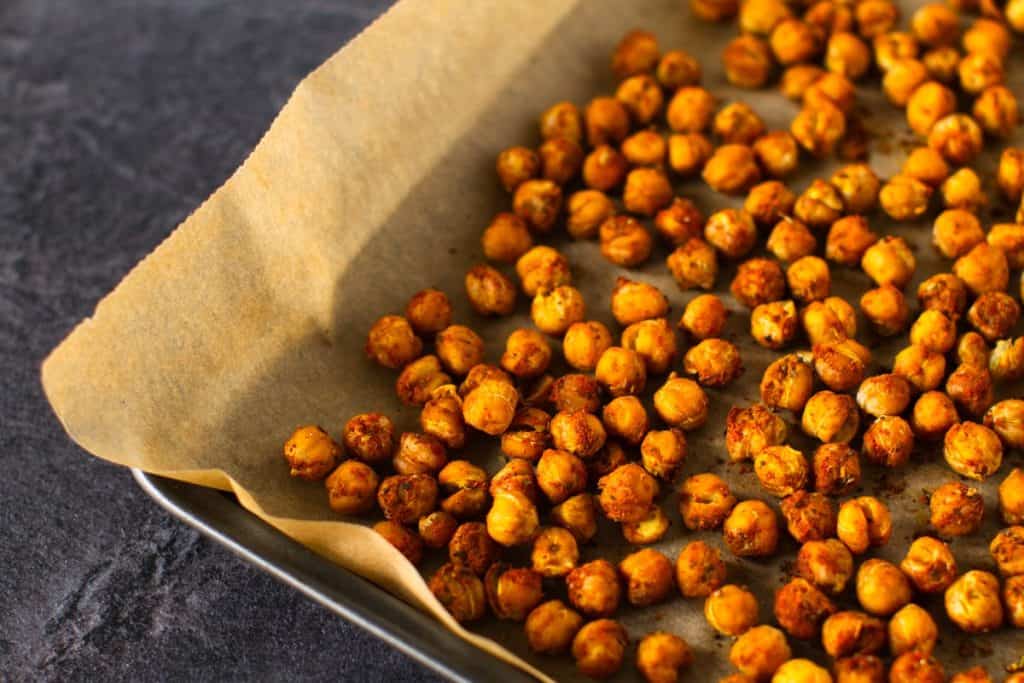
Many other types of beans offer similar amounts of nutrition, so feel free to experiment around with the bean you like the most.
NoNuts Snack Bars
It can easily seem like there are only two options out there for getting enough protein, meat or nuts. If you don’t want to – or can’t – have either of those rather than finding a protein source can be tough. These NoNuts Snack Bars are a great way to get protein as well as sodium, carbs, and fiber. Unlike other options, these bars use plant protein to power you up. You can also find them in some tasty flavors like chocolate chip and lemon creme.
Avocado/Guacamole
Healthy fat can also be something that is difficult to find if you aren’t able to consume nuts. Luckily, avocado can provide a great solution. Some folks love the flavor of avocado, but not everyone. If you find that it doesn’t quite fit your taste preferences, you can always add in some seasonings like salt or pepper or try using it to make guacamole.
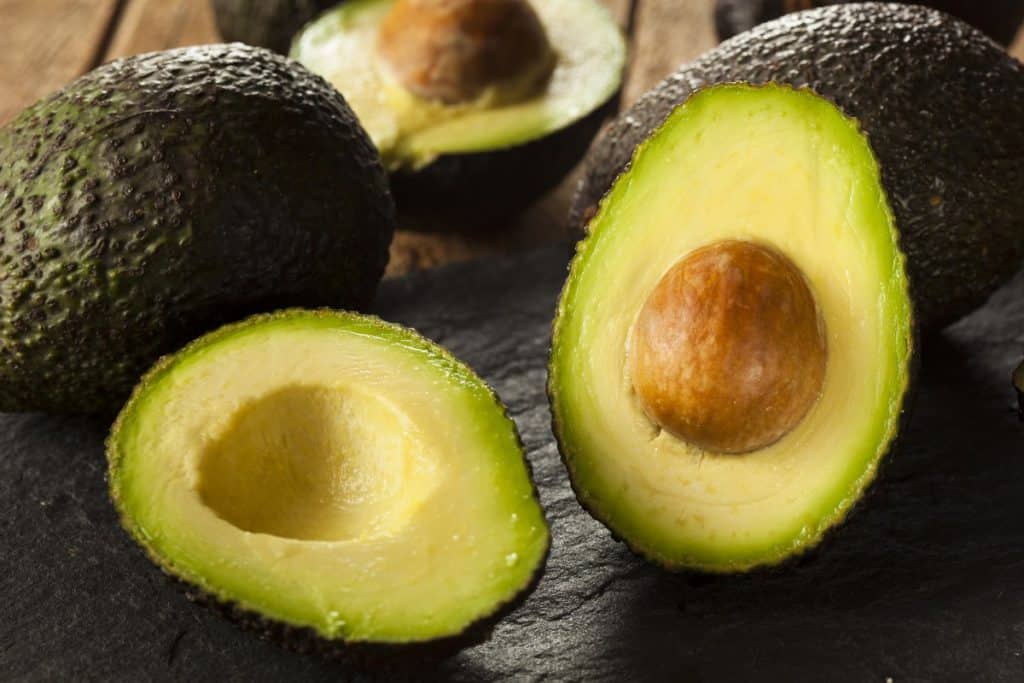
If you decide you do like avocados, then make sure the ones you pack are underripe unless you plan on eating them on the first day.
Seed Butters
If you look hard enough, there are alternatives out there for just about everything. For hikers who want an alternative to nut butter, seed butter can be just as effective. They offer the same kinds of healthy fats, but without risking an allergic reaction. Additionally, there is a huge selection, including pumpkin seed butter, poppy seed butter, and even watermelon seed butter.
Even though you’ve eaten your hiking snacks, you might just find that your stomach is demanding more once your hike is finished. Why is this? Learn all about why hikes leave you feeling extra hungry in our article here.
